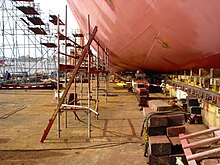


Anti-fouling paint is a specialized category of coatings applied as the outer (outboard) layer to the hull of a ship or boat, to slow the growth of and facilitate detachment of subaquatic organisms that attach to the hull and can affect a vessel's performance and durability. It falls into a category of commercially available underwater hull paints, also known as bottom paints.
Anti-fouling paints are often applied as one component of multi-layer coating systems[1] which may have other functions in addition to their antifouling properties, such as acting as a barrier against corrosion on metal hulls that will degrade and weaken the metal,[2] or improving the flow of water past the hull of a fishing vessel[3] or high-performance racing yachts. Although commonly discussed as being applied to ships, antifouling paints are also of benefit in many other sectors such as off-shore structures[4] and fish farms.[5]
- ^ "Coating Systems For Underwater Hull Surfaces". NSTCenter. Naval Surface Treatment Center. Retrieved 2016-07-03.
- ^ "Marine Corrosion Explained". MarineCoatingPaint.com. June 29, 2015. Archived from the original on January 8, 2016. Retrieved 2015-10-31.
- ^ Are foul-release paints for you? Coating calculator Archived 2011-07-17 at the Wayback Machine, National Fisherman
- ^ Mitchell, Mike J. (2005-04-03). Antifouling Coatings For Offshore Structures. OnePetro. S2CID 137437167.
- ^ Braithwaite, R. A.; McEvoy, L. A. (2005). "Marine biofouling on fish farms and its remediation". Advances in Marine Biology. 47: 215–252. doi:10.1016/S0065-2881(04)47003-5. ISBN 9780120261482. ISSN 0065-2881. PMID 15596168. S2CID 19773748.